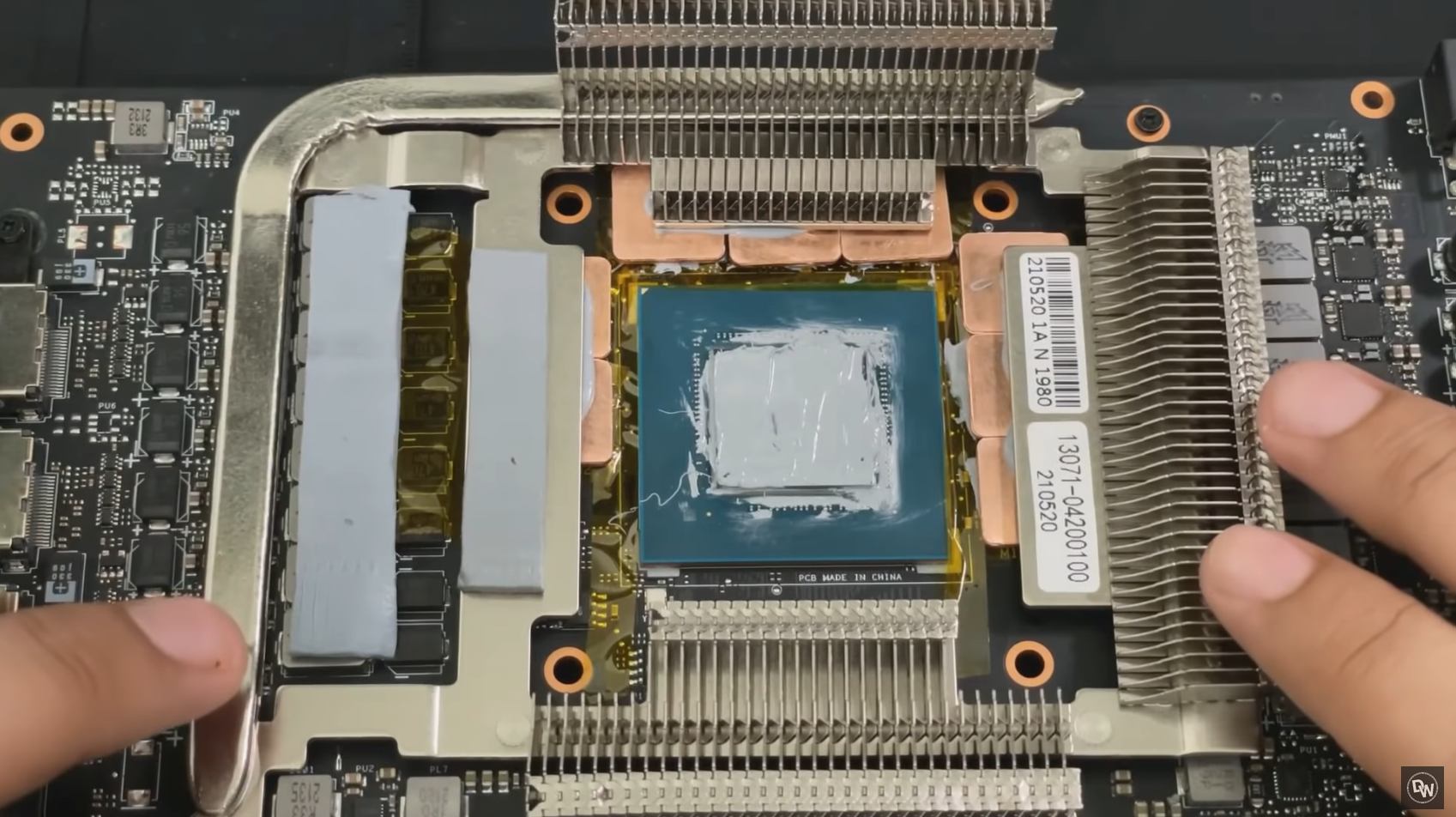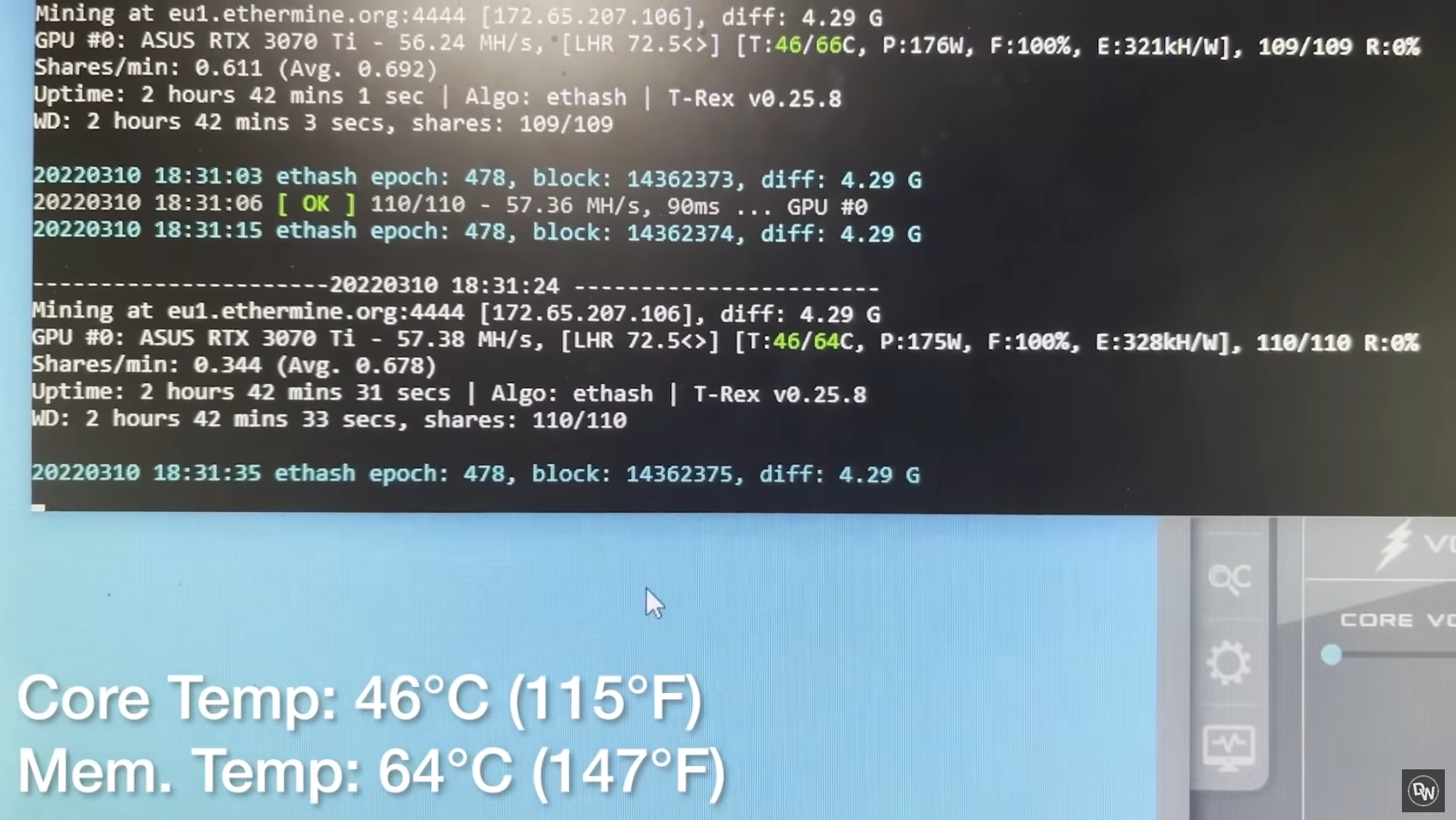Modder Reduces GDDR6X Temps by 46C With Copper Cooling
Copper shims to the rescue!
GDDR6X video memory is known to run notoriously hot on Nvidia's latest RTX 30-series graphics cards. While these are some of the best gaming GPUs on the market, the high memory temps have been an ongoing concern. Hardware modder and YouTuber DandyWorks recently shared a new video, showing how a memory cooling modification involving copper shims as a replacement for thermal pads, and the gains are seriously impressive.
The mod was able to reduce the GDDR6X temperatures on an Asus TUF RTX 3070 Ti by a whopping 46 degrees Celsius, from 110C to 64C. While that's an amazing improvement by simply swapping out thermal pads for copper, the process is rather complicated. If you're interested in performing the mod yourself, be prepared to put in a fair amount of work. Also note that the Asus TUF GPUs are known to have relatively poor GDDR6X cooling, so the gains might not be as significant with other RTX 30-series cards.
Dandy shows that the mod for his particularly card requires three components: copper shims, non-conductive Kapton tape, and thermal paste with an applicator. Additionally, you might need 400 grit sandpaper for smoothing out the copper shims.
The copper shims should be 0.2mm thinner than the size of the thermal pads to work properly. Again, some experimentation may be required, depending on your particular card. If your graphics card uses a separate cold plate for cooling the memory, you may be able to get away with slightly thicker copper shims that are the same size as the thermal pads.

You'll need to search online or dismantle your graphics card to see which method of cooling it uses. Otherwise, the basic process will be similar, regardless of your particular GPU.
You remove the cooler from the graphics card, replace the thermal pads on the GDDR6X (or other) memory modules with copper shims sandwiched in-between thermal paste — don't use too much or too little. You'll also want to put layers of Kapton tape all around each module to ensure a short doesn't occur, as that can kill the graphics card.
GDDR6X Copper Cooling Results
After the mod was complete, Dandy fired up T-Rex, a cryptocurrency mining app for Nvidia GPUs, and ran it for over two and a half hours. Results showed the memory temps operating at an incredible 64C, which is a 46C drop from the card's original temperature of 110C with the stock thermal pads.
If you have an RTX 30-series card that is running borderline temps of 106C–110C on the GDDR6X modules, this mod could be beneficial to you. Lowering memory temps will give the memory additional overclocking headroom, and that's beneficial for gaming as well as mining applications. It should also improve the lifespan of your card. While Nvidia rates the memory for up to 110C, many are concerned that cards won't last more than a few years if they continually run at such high temperatures.
Get Tom's Hardware's best news and in-depth reviews, straight to your inbox.

Aaron Klotz is a contributing writer for Tom’s Hardware, covering news related to computer hardware such as CPUs, and graphics cards.
-
InvalidError Shouldn't come as much of a surprise when so many GPUs have 3+mm thick squishy thermal pads. Reduce the pad thickness to something more reasonable like 0.5mm total (ex.: 0.5mm pad from shim to HSF plate to accommodate mounting compression, paste on chip side) and you get a substantial cooling increase.Reply -
Geef Hopefully video card companies will take a look at this and make their next gen cards using this method.Reply -
King_V Well, I guess if they can't be troubled to be more careful with thermal pad thickness, then hoping for them to maybe incorporate copper into their cooling for the VRAM is really asking a lot.Reply -
zipspyder Seems like the OEM's could do a better job of memory cooling. The prices they charge can't be a hindrance at this point.Reply -
InvalidError Reply
As the DRAM dies are encapsulated in plastic or epoxy which usually have horrible thermal conductivity and only dissipate about 2W each, replacing most of the thermal pad thickness by nearly any metal would still be a significant improvement. GPU manufacturers could just make the GPU aluminum plate large enough to cover the VRAM and a deeper pocket for the GPU die's vapor chamber, no extra parts or assembly needed unlike the shim work-around, though this would require a few extra seconds of machining and maybe a dime worth of extra aluminum for the bigger base block instead of pennies for the shim which would require its own separate manufacturing steps.King_V said:Well, I guess if they can't be troubled to be more careful with thermal pad thickness, then hoping for them to maybe incorporate copper into their cooling for the VRAM is really asking a lot. -
wifiburger Have bunch of these mem copper shims that I have yet to install on my 3090.Reply
You can get pretty close to those copper shims if you use high performance thermal putty due to PCB warp.
My rtx3090 with modified EK block uses 0.5mm thermal pads for all the front.
The rear, uses 1mm pads, that I could use 0.5mm copper shims but too lazy now.
Have a low profile heatsink with thermal tape + 80mm noctua on the backside, I don't think i see more than ~55c for gaming. -
escksu ReplyInvalidError said:Shouldn't come as much of a surprise when so many GPUs have 3+mm thick squishy thermal pads. Reduce the pad thickness to something more reasonable like 0.5mm total (ex.: 0.5mm pad from shim to HSF plate to accommodate mounting compression, paste on chip side) and you get a substantial cooling increase.
Not really possible, It will make the card way too expensive to produce.
The reason behind the thick pads are due to the variation in height of the ram on the circuit board and the heatsink.
When machines place the ram on circuit board and subsequent heating, there will always be minor variations. The heatsinks are most cast aluminum and assembled then machined.
If you have extremely tiny tolerance, it will slow production down and going to be very expensive. -
samopa If you paid $1000+ for GPU, you hoped that they already do something like this in their factoryReply -
InvalidError Reply
While there may be variations, they are typically in the order of 0.1mm even between manufacturers, not multiple millimeters. Designing the HSF to use 0.2-0.5mm thick pads instead of 3-6mm ones doesn't require much additional effort.escksu said:Not really possible, It will make the card way too expensive to produce.
The reason behind the thick pads are due to the variation in height of the ram on the circuit board and the heatsink. -
Kindachi There’s a small business that started producing copper plates tailored to different GPUs for cooling VRAM, to include the notorious back VRAM on RTX 3090s. Similar results, more accessible, and more models forthcoming.Reply
https://www.coolmygpu.com/

